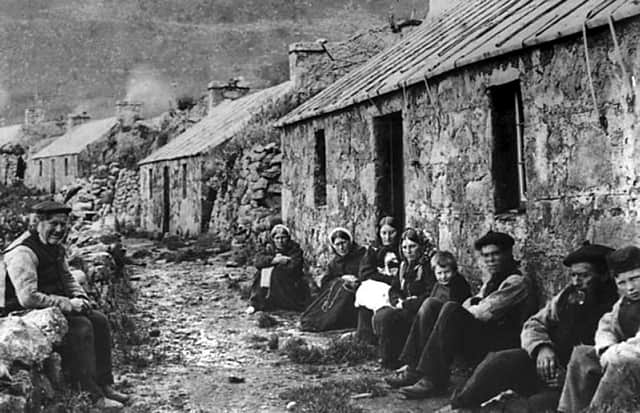Meet the St Kildans - from natural beauties to shoes made from goose heads and puffin porridge


Publications from the late 19th Century, which followed fresh interest in the island among a new breed of Victorian traveller, give an intriguing insight into islanders, their ways and the perceptions of often monied visitors.
Published in 1878, St Kilda, Past And Present features a compendium of writings, from the late 17th Century to the Victorian period, and charts physical characteristics, diet and dress.
Advertisement
Hide AdAdvertisement
Hide AdThe good looking appearance of islanders is commented on in several acccounts.
One said: “Both sexes are naturally very grave, and of a fair complexion; there are several of them would be reckoned among beauties of the first rank, were they upon a level with others in their dress.”
Reverend Macaulay from Ardnamurchan described the island women as “most handsome” with regular and fine features.
“Some of them, if properly dressed and genteelly educated, would be reckoned extraordinary beauties in the gay world,” he added.
Some accounts note the white teeth and bright eyes of islanders, with men – “stout and active” – usually wearing beards. Measurements of height show the men most were usually around 5ft 6ins tall.
Others were harsher in their assessment, with one account claiming the islanders emitted a “disagreeable odour” given the “oily nature of their sea-fowl food”.
Separate census records show that St Kildans each ate 18 seabirds and 36 seabird eggs a day, with mutton also on the menu in the late 18th Century.
Martin Martin, the first visitor to give a written account of his trip to St Kilda, which was documented in 1697, wrote extensively on the island diet.
Advertisement
Hide AdAdvertisement
Hide AdHe wrote of the sea-fowl dried in small stone houses with each family having around three or four barrels of salted fulmars - “ a flavour like salted pork” – for winter with solan goose and puffin also hunted and consumed.
The account added: “Their principal food in summer is roasted puffin. For breakfast, they have some thin porridge or gruel, with a puffin boiled in it to give it a flavour.
"Dinner consists of puffin again, this time roasted, with a large quantity of hard-boiled eggs, which they eat just as the peasantry eat potatoes; They use no vegetables, except a few soft potatoes, not unlike yams.
"They consume very little meal, as their crops are not good, and are liable to being swept off by the fierce equinoctial gales. Bread is considered a great luxury, and is only used at christenings, weddings, and the New Year. The latter is quite a time of feasting, as each family kills a sheep, and bakes oatmeal cakes. The principal drink is whey. No vegetables can be raised owing to the showers of spray that dash over the island. Even kail plants are with difficulty reared.”
On clothing, men wore small flat blue bonnets, coarse yellowish-white woollen jerkins, and wooly trousers.
Women wore a piece of linen on their heads, which drew to a small point below the shoulders with “a lock of about sixty hairs hanging down each cheek.”
An account added: “Their plad, which is the upper garment, is fastened upon their breasts with a large round buckle of brass, in form of a circle.”
Footwear is also noted.
The account said: “They wear no shoes or stockings in summer; the only shoes they wear are made of the necks of solan geese, which they cut above the eyes; the crown of the head serves for the heel, the whole skin being cut close at the breast, which end being sewed, the foot enters into it, as into a piece of narrow stocking.
Advertisement
Hide AdAdvertisement
Hide Ad"This shoe doth not wear above five days, and, if the down-side be next to the ground, then not above three or four days.”
Mark Bridgeman, author of Blood Beneath Ben Nevis, has been researching St Kilda and its people in project with West Highland Museum in Fort William, to mark the 90th anniversary of the evacuation of St Kilda, when the last permanent 36 residents left their homes behind.
Mr Bridgeman said: “Part of the island story is that it has long fascinated people - and it still does.”
A message from the Editor:Thank you for reading this story on our website. While I have your attention, I also have an important request to make of you.With the coronavirus lockdown having a major impact on many of our advertisers - and consequently the revenue we receive - we are more reliant than ever on you taking out a digital subscription.Subscribe to scotsman.com and enjoy unlimited access to Scottish news and information online and on our app. With a digital subscription, you can read more than 5 articles, see fewer ads, enjoy faster load times, and get access to exclusive newsletters and content. Visit https://www.scotsman.com/subscriptions now to sign up.
Our journalism costs money and we rely on advertising, print and digital revenues to help to support them. By supporting us, we are able to support you in providing trusted, fact-checked content for this website.
Joy Yates
Editorial Director
Comments
Want to join the conversation? Please or to comment on this article.